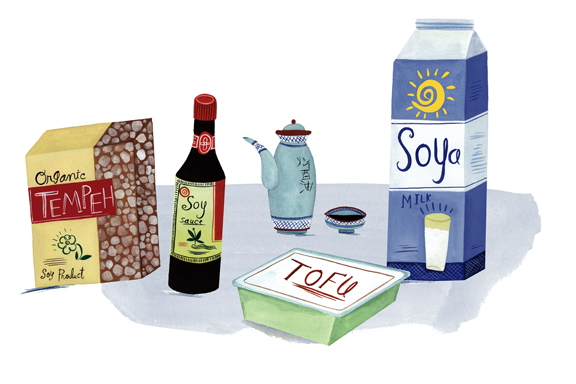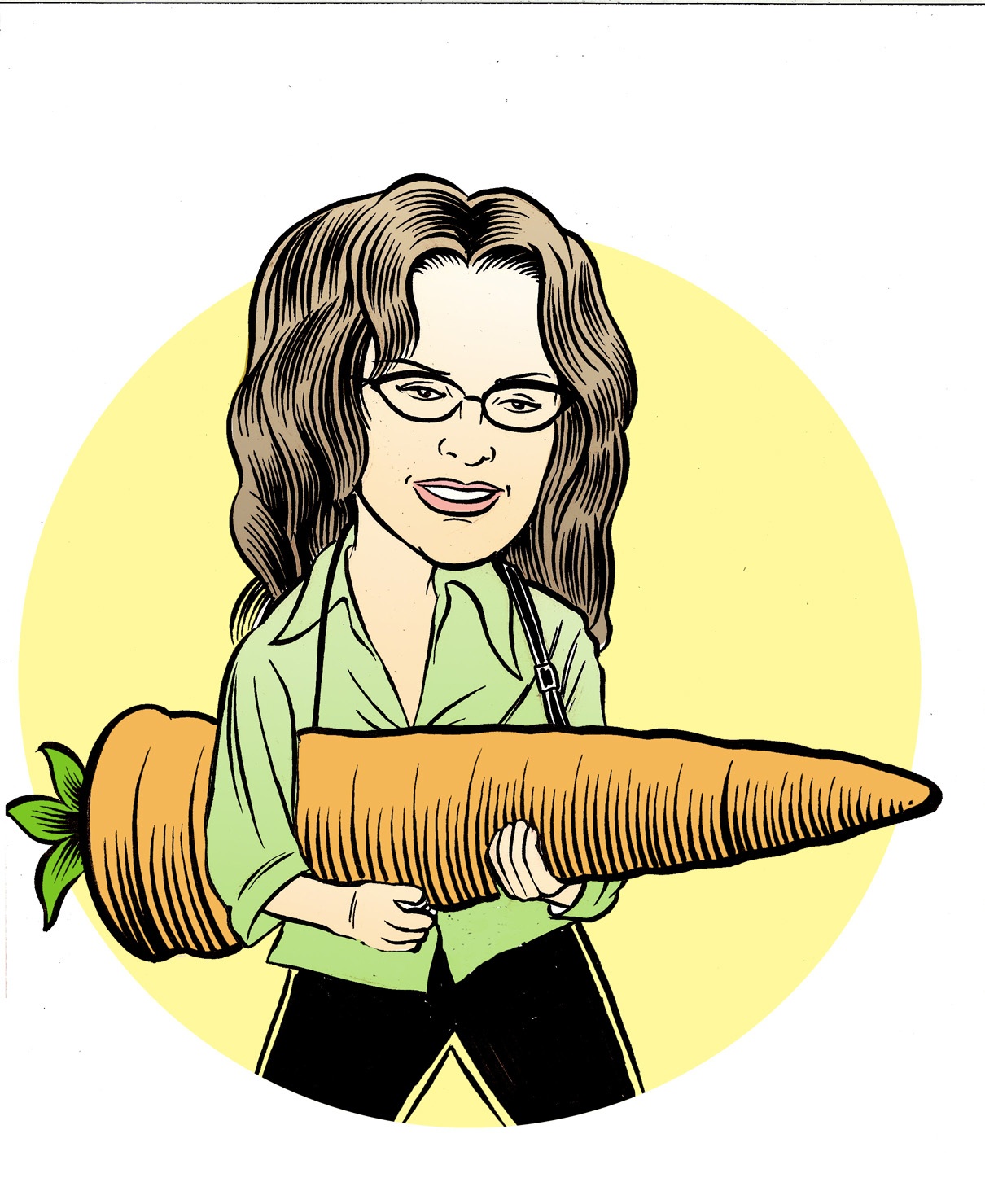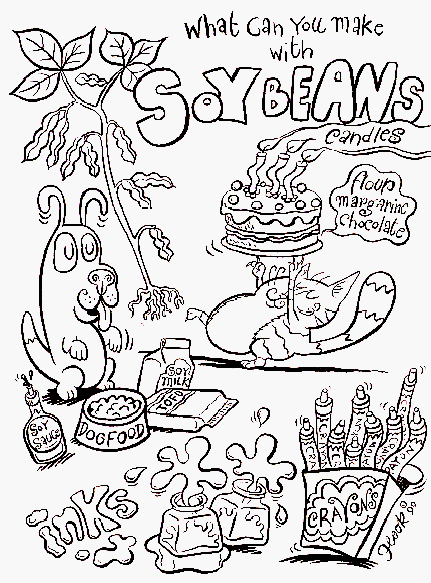
 BY ELIZABETH FIEND You wait and wait, eagerly anticipating your favorite time of the year, and suddenly, it’s here! April is National Soy Month, the most delicious month of the year! Soy is one hell of an amazing plant, one that’s been part of the human diet for over 5,000 years. But it’s much, much more than just veggie burgers. The soybean is also used as food for livestock and it has all the properties of petroleum — except unlike petrol, soy is biodegradable. Wow, doesn’t knowing that you could fuel up your car or feed your cow with it make soy even more mouth-watering, appetizing and desirable to you?
BY ELIZABETH FIEND You wait and wait, eagerly anticipating your favorite time of the year, and suddenly, it’s here! April is National Soy Month, the most delicious month of the year! Soy is one hell of an amazing plant, one that’s been part of the human diet for over 5,000 years. But it’s much, much more than just veggie burgers. The soybean is also used as food for livestock and it has all the properties of petroleum — except unlike petrol, soy is biodegradable. Wow, doesn’t knowing that you could fuel up your car or feed your cow with it make soy even more mouth-watering, appetizing and desirable to you?
This bean’s potential is astounding.
Ben Franklin was so intrigued by the story of a “cheese” made from a bean he acquired some seeds, soybeans actually, and sent them to his West Philly homey John Bartram’s estate. Ben also sent along directions on how to turn the beans into curds, aka tofu. Despite Ben’s efforts, soy never really caught on in Ye Olde America, and was primarily grown for livestock feed and oil until food shortages during WWII stimulated interest in the plant as a source of food for human beans. Tofu, which had Ben so jazzed up, wasn’t sold in an American supermarket until 1958. Not coincidentally, I made my own debut that year.
Franklin was only one great thinker (and eater) who was intrigued by the potential of the plant from Asia. Both George Washington Carver and Henry Ford donated a great deal of their lives to this marvelous bean. Carver, the African-American educator and agricultural genius, began investigating soy in hopes it would become a crop newly-emancipated slaves might use to gain financial independence. His soy products include candles, soups, coffee, cheeses, ice cream, flour and oil.
newly-emancipated slaves might use to gain financial independence. His soy products include candles, soups, coffee, cheeses, ice cream, flour and oil.
Henry Ford also had a million projects going on involving soy and dedicated the last two decades of his life to the bean. Among other things, he unveiled a car made with soy-composite body parts in 1941 and was known to be out and about town in a suit spun out of soy.
As a food, soy can’t be beat. It’s packed with more protein than any other bean. In fact, the soybean is the only plant food source that contains ALL of the nine essential amino acids, making it equal to the protein from animal sources. But unlike animal products, soy has no cholesterol and is much lower in saturated fat. It’s loaded with fiber and nutrients such as phosphorus and vitamin E. It contains antioxidants and has shown promise in lowering LDL, or “bad” cholesterol. Soy may also prevent heart disease and cancer, and alleviate the symptoms of menopause because it tricks the body into thinking it’s getting the hormone estrogen. Because soy isoflavones seem not only to prevent bone loss, but actually build bone, many soy products contain added calcium to help your body maximize this benefit.
Blame it on the hippies.
So if soy is so good, why does it have such a bad rap with the American public? In the early 1970s, the health food movement emerged big time. Propelled by granola-eating, Earth Shoe-wearing, anti-war hippies, it got a “liberal” stigma, which is really nonsensical yet has persisted. Soy is also linked to vegetarianism, which is not the case in any other part of the world. And what can I say, Americans hate vegetarians.
Tofu: The other other white meat.
The American family is just beginning to embrace soy. Manufacturers and admen work hard to make this happen, but the country still refuses to embrace tofu. Imagine in the 1950s, a typical nuclear family sitting down to a dinner of sushi? Forget about it. But today, sushi is eaten with chop sticks as a convenience take-out food by teenagers and Dads alike. But tofu? No way. Tofu hasn’t made the leap. It’s still yucky to Dads.
Tofu, frankly, is unlike any other ingredient Americans eat. Forget the raw, white, gelatinous blob you tried and hated. Save that experience until your taste buds have matured and you can really groove on it. Instead, try some baked tofu. Make your own (my recipe is below) or buy already baked. When cooked properly, it’s so scrumptious and, and as a bonus, tofu is almost always organic! And it’s super cheap.
Blame it on the Baby Boomers.
Even though tofu hasn’t yet broken through into the culinary mainstream, we have seen an increase in the number of mainstream food products containing soy. Ever since soy isoflavones were linked to the relief of menopausal symptoms, Lady Boomers began seeking ways to incorporate more soy into their diets. Of course, they just wanted to take a pill. But isoflavones in pill form have not been proven effective, as in many other cases, eating the whole food is the way to go.
Boomers have been driving the economy since they dealt their first bag of weed. When this large generation reached menopause, their abundant disposable income demanded soy convenience foods and we began seeing more and more food products made out of soy. Soy milk is a prime example. You can get it at any supermarket in the refrigerator section, right next to cow’s milk. It’s great on cereal and definitely worth a try, but look for a brand that has the certified organic seal on the carton.
Whip up your own soy milk fruit smoothies. The ones you buy at an ice cream or juice stand are loaded with carbs. (Anytime you see a beverage made with bananas AND orange juice, back away unless you want to gain weight.) Instead, what I’d suggest is get a bag of frozen mangoes, pop them in a blender with some soy milk. Don?t add sugar! Instant, creamy, healthful, it’s a filling, refreshing summer breakfast.
Soy in bean curds = Out, Edamame = In.
Tofu may not have made the leap into cool but edamame, the fresh green soy bean, has. You can buy frozen bags of them, in or out of the pod. Great for snacks, or use like any other green vegetable. Toasted soy nuts make good snacks too, they’re lower in fat and calories than peanuts. You can even enjoy soybean sprouts in sandwiches and salads. Soybean oil is used for frying, in baked goods and in salad dressings — it’s even used as a non-toxic filler for some for breast implants! (Soya Oil / Trilucent Breast Implants).
Fermented soy is especially nutritious. Use miso, a fermented soybean paste, in soups and sauces. Stir in a spoonful or so, but add it at the last minute, as boiling miso destroys the beneficial enzymes. Miso is also great for making salad dressings. My favorite is made with ginger, miso, a touch of sesame oil and some orange juice.
Tempeh, a cultured cake of beans and grain and a staple in Indonesia, is also made from fermented soy. It is the most healthful of all soy products. It’s so special in fact, that I’ll write a future article about this mysterious food. If you haven’t dined on my tempeh BBQ ribs, you haven’t lived yet. If you want a dinner invite, leave a comment on this blog.
Analog, not digital.
And of course there are the tofu hot dogs and veggie burgers. In fact, the supermarket aisle are full of meat analogs — that is, fake meat — in the form of sausage, ground beef, cold cuts, chicken nuggets, meatballs and more. Most of these meat analog products are actually blends of soy and wheat. And unless it says organic on the label, you can pretty much be assured that it’s made with genetically modified soy.
Not all of these meat analogs are created equal. Check the package for nutritional information; especially look at the fat grams, calories and sodium. I’ve seen some brands of vegetarian kielbasa that have 13 grams of fat. Absurd! There is absolutely no reason to eat a veggie product that’s higher than 7 grams of fat per serving, and many, like Boca Burgers (2.5 grams of fat), go much lower.
If you don’t like one brand, try another until you find one you like. Generally, you don’t want to microwave these things, even though they provide microwaving instructions. Would you microwave a hamburger? Of course not, it would taste like crap — and so will the meat analog. Grill, bake, pan fry in a teensy bit of fat, or stir fry. Don’t over cook.
For optimum health it’s recommended you eat one or two servings of soy a day, which equals 40 mg of isoflavones. As always, avoid highly processed foods.
Elizabeth Fiend’s BASIC BAKED-TOFU
Cooking Time: 45 min., Active time: 10 min., Servings: 4
In America in the ’60s and ’70s when tofu was first coming into recognition by the crunchy, granola eating set the suggested preparation method for cooking tofu was very complicated. It usually involved pressing the tofu under weights and marinating it for hours before cooking. I have combined all those steps into one easy method that’s basically dry rub then bake! Baked tofu is so good and versatile to use I often double this recipe and cook 2 lbs. of tofu at once.
Quick and easy uses for baked tofu:
Use baked tofu in sandwiches. Slice or dice baked tofu and substitute for chicken in any of your favorite recipes. Add it to a can of soup for an instant upgrade in flavor and nutrition. Add, with vegetables, to ramen noodles, or combine with vegetables in a stir-fry. You may want to add the tofu to your dish at last minute to preserve its texture.
Ingredients:
1 lb EXTRA firm tofu
2 tsp soy sauce
2 tsp garlic powder
2 tsp powdered ginger
? tsp dry mustard
spray olive oil
Method:
Preheat oven to 400 degrees.
Open tofu package — discard water
Slice tofu on the shortest side of the block into 8 pieces
Spray baking sheet with olive oil and lay slices of tofu on baking sheet
Sprinkle on top of the tofu the garlic, ginger and mustard or your favorite seasonings
Shake on the soy sauce (don’t overdo the salt!)
Bake for 25 minutes or until the bottom is golden and crispy
Slide a thin spatula under each piece of tofu and flip
Spray light coating of olive oil over top of tofu
Bake for 20 more minutes or until the bottom is golden and crispy
You want the tofu to be slightly crisp on the outside and soft and chewy on the inside. Overbaking will result in tofu-jerky; underbake, and the tofu won’t have as interesting a texture.
Elizabeth’s secret steps: When done cooking, remove the tofu from the oven and flip it over one more time. This will release heat and moisture, preserving the crispy texture of the tofu. To preserve the texture, don’t refrigerate until completely cooled.
————————————————————————————————————
How do you use that baked tofu?
RED x 3
by Elizabeth Fiend
Time: 1/2 hour-ish, Serves 4, Vegan
Red foods generally contain more vitamins than their less showy cousins. Take advantage by combining 3 red vegetables and tofu in this spicy Korean flavored, one pot vegan meal. It’s the perfect dish for those with roommates. (cuz you know they never wash the dishes)
Loaded with antioxidants!
SEASONING Ingredients
1 t sesame oil
3 or more cloves fresh garlic — minced
2 T fresh ginger — minced
HOT pepper flakes (to taste, I recommend a lot!)
RED STUFF
2 RED onions — sliced into ? moons
2 RED peppers — cut into match sticks
1/2 head RED cabbage — shredded
PROTEIN
1 lb. firm tofu – baked & cut into cubes (see recipe above)
SAUCE
1 T light soy sauce
1/4 c lime juice
1/4 c brown sugar
1/4 c chopped cilantro
TOPPING (more protein!)
1/2 c walnuts pieces
COOK IT
In a non stick pan or wok, saute garlic, ginger & hot pepper in sesame oil
(when dry: do NOT add more oil, add water)
add onions, cook till just translucent
add red peppers, cook till skins are soft
add cabbage, don’t overcook!
add baked tofu cubes & cook until heated thru
stir in sauce ingredients
adjust to taste
dish up
top with nuts
eat
Note: This dish doesn’t make good leftovers as the red cabbage tends to dye the tofu an unsightly color.
For more information:
George Washington Carver
http://www.lib.iastate.edu/spcl/gwc/bio.html
Henry Ford
http://www.karlwells.com/nov2003.htm
National Cancer Institute
http://www.cancer.gov/prevention/agents/Soy_Isoflavones.html
Soy and menopause
http://health.ivillage.com/eating/ewsoy/0,,32k,00.html
Food and Drug Administration
http://www.fda.gov/Fdac/features/2000/300_soy.html
ABOUT THIS COLUMN: At no time in recorded history have we possessed so much knowledge about health and nutrition, nor have we ever had such vast and effective machinery for disseminating that knowledge — and yet, for all intents and purposes, we live in hi-tech Dark Age with the vast majority of the global population essentially ignorant or confused about the basic facts of their own biology. How did this happen? Well, that’s a whole six-part mini-series in and of itself, but the short answer is that the bottom line of many a multi-national corporation is dependent on that ignorance, and vast sums of money are expended to maintain it. The global warming argument is a classic example. When scientific fact did not favor Big Oil, they hired their own scientists to to conduct and publish studies that contradicted the peer-reviewed facts about the environmental impact of carbon-based emissions. As a result, whenever the latest global warming news is relayed to the public, it always comes with the caveat that “some dispute these findings.” There was time when newspapers saw it as their duty to truth squad these debates, but that’s long since become a luxury most papers can no longer afford — better to hire another gossip columnist and give the people what they want. To fill this crucial gap, Phawker began publishing Elizabeth Fiend’s JUNK SCIENCE column. Every week, Miss Fiend connects the dots to reveal a constellation of scientific facts that have been hiding in plain sight — scattered across the vast, cold reaches of the Internet. With a background in punk rock and underground comics, and longstanding employment as a de facto research librarian, Miss Fiend doesn’t pretend to be a scientist or an expert. She does, however, know how scientific facts become diluted by corporate-sponsored non-facts, and every week she separates the smoke from the mirrors. Why? Because she loves you.
